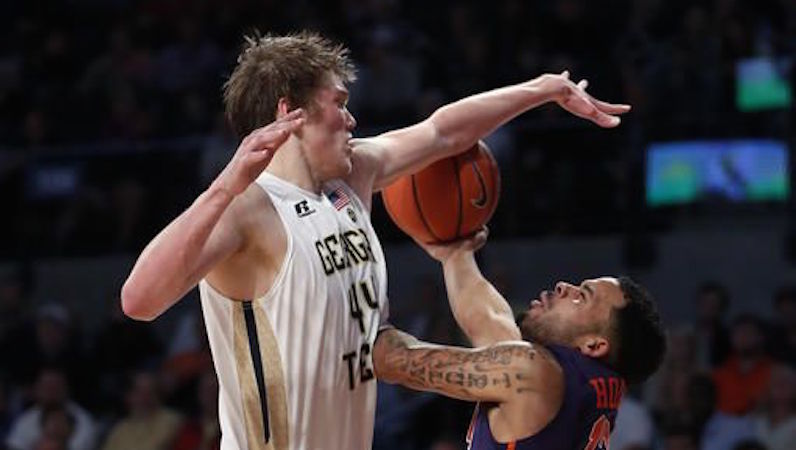Basketball teams — in college and in the NBA — are shooting more three-pointers than ever before. It’s a critical component of almost every functional offense: shoot three-pointers, efficiently.
However, the most important shot for an offense to get occurs right at the hoop. A dunk or layup at the basket is always the optimal play; that will never change. If a team could get a quality look at the rim on every possession, they would be the greatest offense all-time.
Also, part of why teams shoot so many threes is that it forces defenses to guard space 20-plus feet away from the basket. Which in turn opens up prime real estate in front of the rim.
What does this mean for defenses?
No easy buckets.
More specifically, though: the best defenses know they have to wall off that rim. Now, that’s easier said than done. It takes more than just an elite shot-blocker as a defensive anchor, although that really helps.
Here’s a look at how each ACC team from the 2016-17 season stacks up on defended field goals at the rim.
| Team | FG% | Block rate | Unblocked FG% | Defensive rating |
|---|---|---|---|---|
| Georgia Tech | 51.3% | 20.8% | 64.7% | 91.0 |
| FSU | 53.6% | 16.5% | 64.2% | 95.4 |
| Virginia | 53.7% | 18.5% | 65.9% | 87.9 |
| Miami | 57.5% | 12.5% | 65.7% | 94.8 |
| Louisville | 58.1% | 16.7% | 69.7% | 91.7 |
| Pitt | 59% | 11.3% | 66.6% | 103.7 |
| NC State | 59.3% | 13.0% | 68.2% | 107.6 |
| Clemson | 59.9% | 12.8% | 68.7% | 100.5 |
| Syracuse | 60.0% | 16.7% | 72.0% | 102.3 |
| Notre Dame | 60.1% | 11.0% | 67.6% | 98.4 |
| BC | 61.6% | 8.7% | 67.5% | 104.2 |
| Virginia Tech | 62.0% | 9.6% | 68.5% | 103.6 |
| Wake Forest | 62.2% | 13.4% | 71.8% | 104.6 |
| Duke | 62.5% | 10.7% | 70.0% | 96.9 |
| UNC | 62.6% | 10.1% | 69.6% | 92.5 |
If you follow ACC ball, it’s no surprise to see Georgia Tech top this list. The Yellow Jackets, winners of 21 games, made a mark this season with a stifling defense and an opportunistic back-cutting offense.
According to KenPom, Tech ranked No. 6 in Division I basketball in defensive efficiency: 91 points per 100 possessions.
The Difference Makers
Georgia Tech was anchored along the baseline by center Ben Lammers. After two seasons spent as a role player, Lammers erupted this season. The 6-10 junior operated as a high-post hub in Tech’s offense; Lammers also became one of the best rejection artists in the league.
Lammers blocked 9.9 percent of his opponents’ two-point field goals when he was on the floor this season. That ranked No. 21 nationally in terms of block rate. According to Synergy Sports, opponents scored less than 0.8 points per possession on post-ups against Lammers.
Georgia Tech’s leader blocked an impressive 5.5 shots per 100 possessions, too.
Before an injury cost him much of the season, Abdoulaye Gueye pitched in as well: 6.2 percent block rate. This is how the Jackets teamed up to block nearly 21 percent of their opponents’ attempts at the rim.
Tally up another block
Florida State basketball, under Leonard Hamilton, has become known for the collective team length. It seems like each year the Seminoles have multiple 7-footers on the roster. This past season was no different.
Led by 7-4 Christ Koumadje (12 percent block rate), FSU fielded a roster with four players that had block rates above six percent. Koumadje was joined by Jonathan Isaac (6.2 percent), Jarquez Smith (6.9 percent) and Michael Ojo (7.5 percent).
On the flip side
Wake Forest featured the ACC’s best big man this past season — John Collins. It was no secret, though, that the Demon Deacons struggled mightily on defense. It was the team’s undoing against Kansas State in the NCAA Tournament, when Wake allowed 55 points in the second half.
The Deacs blocked a decent number of shots at the rim — 13.4 percent — but to allow a near 72 percent clip on unblocked attempts is problematic.
According to Hoop-Math, one-third of the shots Wake Forest defended last season came at the rim.
One surprise
I had to do a quick double take when I glanced at North Carolina’s number. One would think that with all of UNC’s size inside that the Tar Heels would’ve kept opponents at a lower field goal percentage at the rim.
Regardless, it didn’t burn the Heels, who finished inside the top 12 nationally in defensive efficiency. It helps, of course, when you have a lockdown wing defender, like Justin Jackson, and clean the glass. Opponents grabbed just 25 percent of their misses against UNC.

















